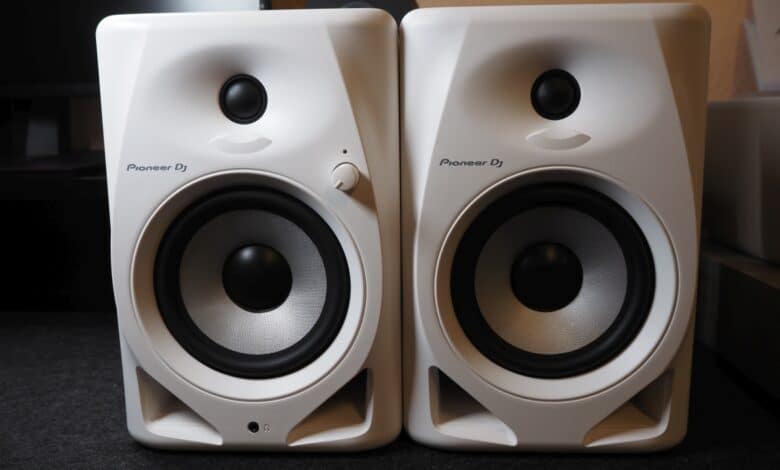
The Pioneer DJ series has made a real name for itself among electro musicians and producers in recent years. Now the manufacturer offers a duo of noble active speakers that want to present themselves as a real all-round solution at a comparatively low price. How well this works and especially sounds, reveals our Pioneer DJ DM-50D test.
Technical data
| Dimensions (W x H x D): | Left: 175 x 262 x 257 mm; Right: 175 x 262 x 247 mm |
| Total weight: | 7.4 kg |
| Frequency range: | 54 Hz – 30,000 Hz |
| Tweeter: | 3/4 inch soft dome |
| Woofer: | 5 inch |
| Power: | 25 watts @ 4 ohms |
| Connection: | 3.5mm stereo jack; RCA; 6.3mm jack R/L |
| Price: | € 279.51 * |
Pioneer DJ DM-50D review: package contents
Safely packed in a box with a handsome weight, the Pioneer DJ DM-50D reach us for the test, which we also inspect without detours. Inside, we are greeted by a small bag along with three cables that are needed to connect the active speakers.
In addition to a 3.5 mm stereo mini jack to RCA cable, Pioneer includes a speaker connection cable with black and red contant, as well as the classic power cable for the power connection. Otherwise, we find a quick-start guide, the usual safety instructions, and four felt stickers each twice in the package, which is rounded out by the two speakers themselves.
Design and finish
Already the packaging of the Pioneer DJ DM-50D suggests a noble design, which the unpacked speakers then confirm once again. Instead of a classic design with minimally offset woofers and tweeters, the manufacturer relies here on many curves in the design language.
In combination with the rounded, omitted triangles on the lower front, this creates a high-quality, futuristic look. For testing purposes, Pioneer provided us with the white version of the DM-50D, which is also available in black. The speakers are made of MDF (medium-density fiberboard) and, with a size of 175 mm x 262 mm x 257 mm, are neither too large nor too small. At the same time, the speakers weigh a decent 3.9 kg (left speaker) and 3.5 kg (right speaker), which speaks for high-quality workmanship.
But first, back to the design. The front section is dominated by a 5-inch fiberglass woofer and a 3/4-inch soft dome tweeter above it. At the bottom, we find a 3.5mm jack connector including a headphone icon on the left speaker, as well as a rotating volume control including an LED power indicator on the right side at mid-height.
The powder-coated vinyl exterior also provides a pleasant feel. The top and bottom sides don’t have any noteworthy features. On the other hand, it gets interesting at the back. While the right speaker only has the connections for the connection cable, all connections and settings can be found on the back of the left active speaker.
In addition to the class 2 cable connector for connecting the speaker duo and the power connector and on/off switch, the inputs are particularly exciting. Here, the Pioneer DJ DM-50D offers almost everything that semi-professional and home users need. 3.5 mm stereo jack, RCA and 6.3 mm jack are available. Only an XLR port is conspicuous by its absence. In addition, there is a switch in the upper left corner on the back that lets us switch between the DJ and Production sound modes – but more on that later.
Workmanship of the Pioneer DJ DM-50D
The build quality of the Pioneer DJ DM-50D is outstanding. Thus, both speakers are characterized by a pleasant feel and high-quality, robust materials. Fortunately, we look for gaps, sharp edges or other inconsistencies in vain. It goes without saying that the diaphragms of the tweeter and woofer should be handled with care due to the soft materials, as they can be easily pressed in.
Initial setup and practice
The initial setup of the Pioneer DJ DM-50D is quick and easy. The first thing to do is to connect both powered speakers together using the included cable. Since the cable itself already has a red and black color scheme, mixing them up is almost impossible. With a length of two meters, the cable allows a decent range to achieve a good stereo sound. Furthermore, the manufacturer points out in the manual that the speakers should be placed at an angle of around 30 degrees to the sitting or listening position.
Then simply plug the power cable into the socket and connect the DM-50D to the desired audio source with the included cable and you’re ready to go. Via the jack cable, the speakers play our music from smartphone, tablet, PC and notebook or other audio sources with the corresponding connection option without any problems.
A bit of a pity: Pioneer completely omits a wireless connection, for example via Bluetooth. Presumably, because the speakers are rather aimed at DJs and producers and not the “classic” home users. Nevertheless: It wouldn’t have hurt in any case.

We also found the volume control on the front to be pleasant during the Pioneer DJ DM-50D test. On the other hand, the fact that the manufacturer has omitted other controls, for example for fine-tuning treble and bass, is also a bit of a shame. However, the feature as a monitor speaker is naturally the focus here as well, which is precisely to ensure an undistorted sound reproduction.
Sound quality of the Pioneer DJ DM-50D
We were particularly curious about the sound of the Pioneer DJ DM-50D, because purely from a technical point of view, the monitor speakers have a lot to offer. Thus, a class D amplifier with a maximum sampling rate of 96 kHZ is at work inside. The pair has a total output power of 25 watts at 4 ohms, which is more than sufficient for home, studio and DJ use in small to medium-sized locations. The same applies to the maximum volume, which comes to a halt at around 90 decibels in our test without distorting.
According to the manufacturer’s promise, the grooved air ducts at the front of the speakers are supposed to reduce air friction to make the DM-50D sound bigger and richer than they actually are. We can also confirm this in large parts, because the illustrated frequency band from 54 to 30,000 Hz presents itself on a broad, melodious stage that can convince in all areas. At the same time, the DECO convex diffuser is supposed to realize a spatial 3D stereo sound – however, we could not notice much of that in the practical test. Stereo: yes, spatial: not really.
Sound-wise, however, the Pioneer DJ DM-50D do a lot right and coped well with all music genres we threw at them. Electro music impressed with convincing bass for the woofer size, while elaborate productions scored with warm, convincing mids and clear highs.
However, the focus is clearly audible on the mids, while especially at high volume the treble can sound unpleasant due to sharply presented S sounds. Nevertheless, the realized sound is more than convincing, especially considering the price. It should also be mentioned positively that the speakers do not produce any perceptible background noise even without active audio playback and at full volume.
DSP Modes: DJ or Producer
Oh, there was one more thing. We still owe you the function of the rear-mounted “Sound Mode” control, which lets us switch between DJ and Producer. Yes… but where is the difference anyway?
When the switch is flipped during playback, there is no noticeable difference in sound at all. According to the manufacturer, the DJ mode is supposed to offer a “powerful sound”, while the Producer option is supposed to be characterized by a more neutral sound. However, no concrete information about this can be found at Pioneer, nor in the user manual.
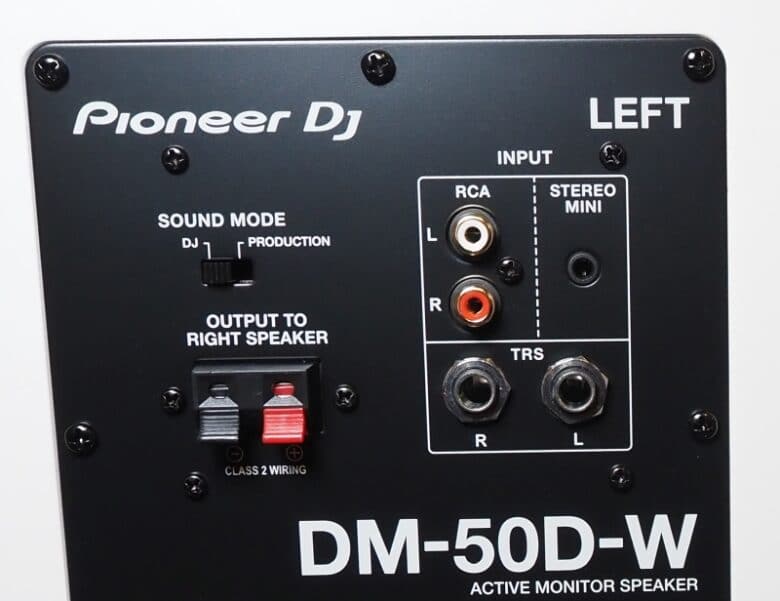
Perhaps the DJ mode sounds a bit more bass-heavy, but those are nuances at best that won’t be noticeable to a layman. Perhaps sound professionals might be able to make out a difference here from a sonic point of view, but we certainly don’t hear it.
Summary of the Pioneer DJ DM-50D
The Pioneer DJ DM-50D score with an attractive price-performance ratio. For around 230 euros, the manufacturer puts together a coherent overall package of high-quality workmanship, chic design and convincing sound here. Thanks to quite compact dimensions and versatile connection options, the 2-way bass reflex active monitor speakers also cut quite a good figure for PC and notebook use.
However, due to the field of application, nice gimmicks like Bluetooth connectivity, equalizer or additional controls have to be waived. At least Pioneer offers Bluetooth in the case of the DM-40BT, which, however, does not quite reach the 50D in terms of sound and, for example, covers a significantly lower frequency band.
The only thing to criticize is the adjustable sound mode, which does not show any differences in sound, and the trebles, which reach their limits with sharp S sounds. Otherwise, however, the Pioneer DJ DM-50D are a well-rounded product.
Pioneer DJ DM-50D
Design and workmanship
Sound quality
Features
Value for money
88/100
Chic and well-made active speakers that score with a convincing sound and excellent price-performance ratio. Bluetooth connectivity would have been desirable, and the two sound modes are largely the same.



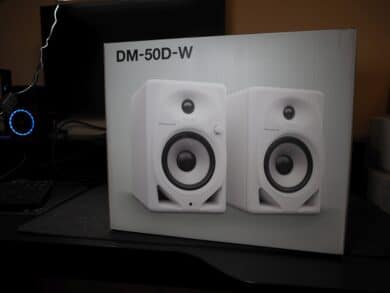
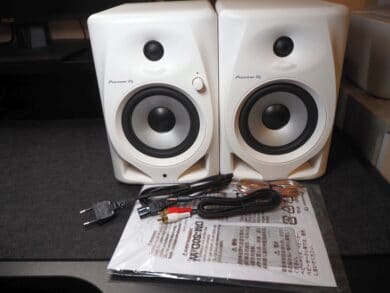

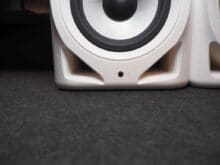

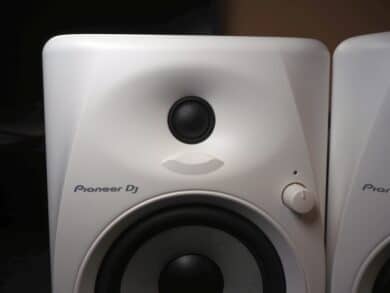
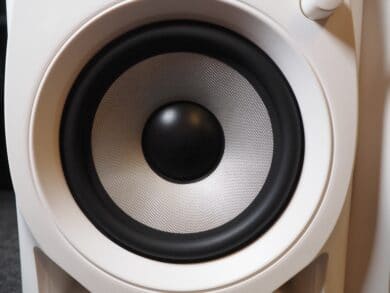
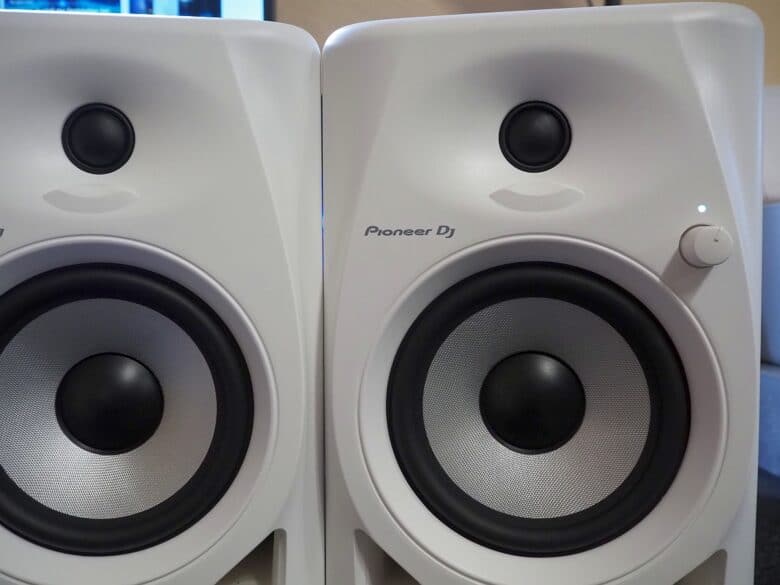





No replies yet
Neue Antworten laden...
Gehört zum Inventar
Beteilige dich an der Diskussion in der Basic Tutorials Community →